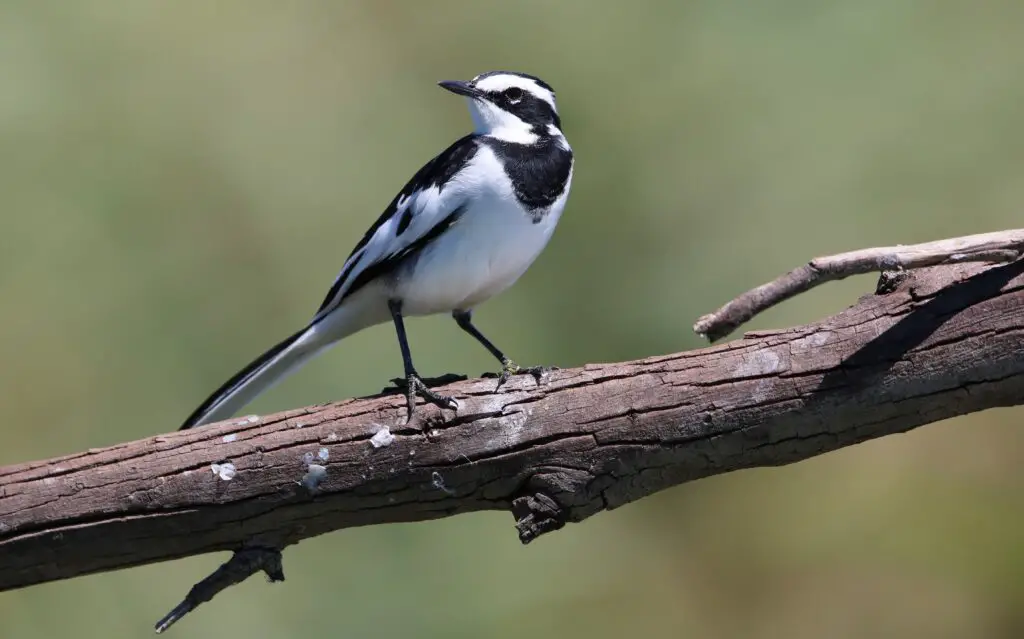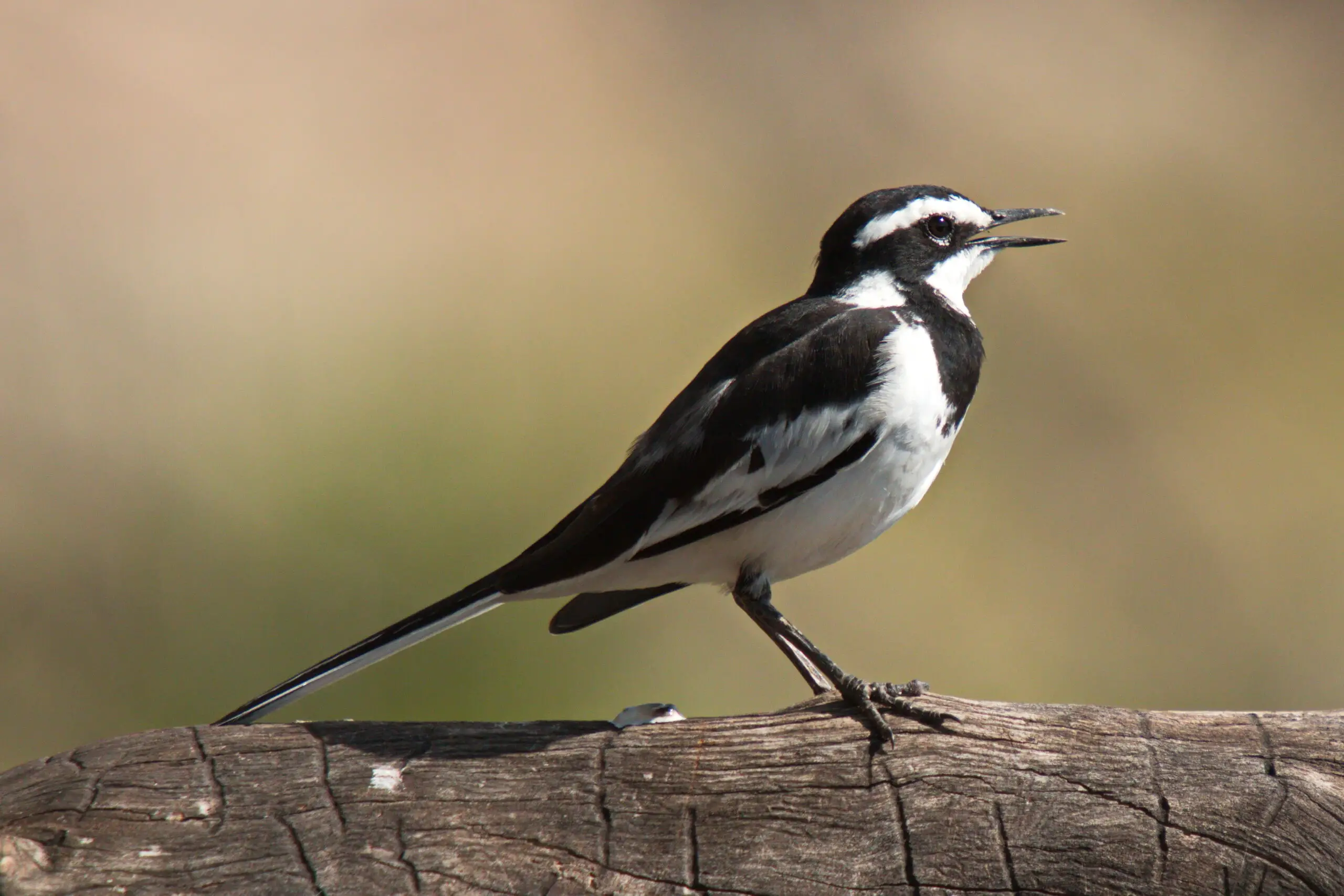The African pied wagtail, scientifically known as Motacilla aguimp, is a small bird belonging to the family of passerines. It inhabits various habitats throughout Africa such as wetlands, savannas, and urban areas.
The species exhibits sexual dimorphism with males having black backs and white underparts while females have greyish-brown backs and pale grey underparts.
African pied wagtails are insectivorous birds with a diet consisting mainly of flies and other aerial insects. They capture their prey by flying low over the ground or water surface before making sudden turns to catch them mid-air.
These birds also feed on spiders found in vegetation near water bodies and occasionally supplement their diet with seeds.
Despite being common across many parts of Africa, there has been limited research conducted on this species leading to gaps in our understanding of its behavior, ecology, and conservation status.

Taxonomy And Physical Characteristics
The African pied wagtail is a small passerine bird that belongs to the family Motacillidae. Its scientific name is Motacilla aguimp, and it is widely distributed across Africa and Madagascar.
Evolutionary history suggests that this species has undergone several diversifications over time, leading to different subspecies with varying physical characteristics.
This bird’s breeding patterns are closely associated with its habitat preferences. It breeds in open areas such as fields or near water bodies throughout sub-Saharan Africa. The African pied wagtail builds its nest on the ground using grasses and feathers, typically laying 3-6 eggs at a time. Both parents take care of their offspring until they fledge after about two weeks.
Physical characteristics of the African pied wagtail include a black head, white eyebrow stripe, and a grey back. They have long tails that they frequently bob up and down while perched or walking along the ground, hence their name ‘wagtail.’ Their diet consists mainly of insects which they catch by foraging on the ground or in mid-air.
Overall, these traits make them well-adapted to their environment and contribute to their successful survival as a species.
Habitat And Distribution
The African pied wagtail is a small passerine bird that belongs to the family Motacillidae. These birds are commonly found in sub-Saharan Africa, particularly in open areas such as grasslands, gardens, and wetlands. The ecological niche of this species is primarily insectivorous; they feed on insects like flies, ants, and beetles. They can also eat spiders and other small arthropods.
African pied wagtails have distinct migration patterns that vary depending on their geographic location. For example, populations living in southern Africa migrate northwards during winter months while those residing in eastern regions move towards coastal areas or inland waterways. During breeding season, these birds build cup-shaped nests made from plant material and mud close to water sources where they lay up to five eggs at a time.
Overall, the habitat and distribution of African pied wagtails are closely related to their food requirements and reproductive needs. As an important member of many ecosystems across Africa, it serves as both predator and prey for various organisms within its environment.
Understanding these factors can help conservationists develop effective strategies for protecting this species and ensuring its continued presence throughout the continent.
Feeding Habits
African Pied Wagtails are known for their energetic and active feeding habits. They primarily feed on small insects, but they also consume aquatic invertebrates such as crustaceans and mollusks. These birds have a unique way of foraging behavior that involves short sprints, hops, and quick movements to catch their prey.
Their prey preferences vary depending on the season and availability of food sources. During breeding seasons, these birds prefer larger insects such as grasshoppers because of their high protein content which is important for rearing young chicks. In contrast, during non-breeding periods, they mostly feed on small flies and beetles.
In summary, African Pied Wagtails exhibit an interesting foraging behavior involving quick movements to catch their preferred prey. Their diet mainly consists of small insects and aquatic invertebrates with varying preferences based on seasonal changes. Knowing about the feeding habits of this species can aid in understanding its ecological role within its habitat.
| Prey | Season |
|---|---|
| Grasshoppers | Breeding |
| Beetles | Non-Breeding |
| Ants | Both Seasons |
| Flies | Both Seasons |
| Crustaceans | Both Seasons |
Behavior And Social Structure
The African pied wagtail is known for its hierarchical social structure, with dominant birds occupying the top of the hierarchy. Dominance hierarchy refers to a ranking system in which individuals compete for resources and status within their group. The higher an individual’s rank, the more access they have to food, mates, nesting sites, and other valuable resources.
Mating behavior in African pied wagtails is also influenced by this dominance hierarchy. Higher-ranking males tend to mate with multiple females while lower-ranking males may not get any mating opportunities at all. Females are typically attracted to high-status males because they provide better protection and resources for their offspring. This can lead to intense competition among male wagtails during breeding season as they try to establish dominance over one another.
Witnessing these complex social interactions among birds can evoke a sense of wonder and amazement.
Understanding how dominance hierarchies influence mating behaviors can be fascinating but also highlight societal issues related to power dynamics.
Observing animals’ intricate social structures reminds us that we are not alone in our need for companionship and community building.
In summary, the African pied wagtail exhibits a clear dominance hierarchy within its species that influences mating behaviors. Studying these behaviors offers insights into animal societies’ complexity and helps us understand human society better. Additionally, observing such intricate social systems in nature has practical applications like improving conservation efforts or understanding why certain groups form stronger bonds than others.
Conservation Status And Threats
The African Pied Wagtail is a small, black and white bird that belongs to the family Motacillidae. This species has an extensive range throughout sub-Saharan Africa, inhabiting various water bodies such as streams, wetlands, and riverside forests. Although this bird’s population size is not accurately known, it appears relatively stable across its range with no major conservation concerns.
However, despite the seemingly secure status of African Pied wagtails in their natural habitats, human activities pose significant threats to their survival. Anthropogenic factors such as habitat degradation through deforestation, pollution from industrial waste and agricultural practices have potential impacts on breeding patterns and foraging behaviours of these birds. Furthermore, urbanization poses a danger to nesting sites due to construction activities resulting in loss of suitable breeding grounds.
Conservation efforts are essential for the protection and preservation of any animal species facing challenges arising from anthropogenic disturbances. In the case of African Pied Wagtail populations, there needs to be more research aimed at understanding both their distribution and behaviour within different regions so that effective strategies can be developed towards mitigating negative human impact on the environment.
Additionally, public awareness campaigns should help promote responsible human behaviours around wetland ecosystems where these birds thrive. Such initiatives would go a long way in promoting sustainable development practices that protect biodiversity while also ensuring continued ecosystem services provision for future generations without negatively impacting vulnerable species like the African Pied Wagtail.
Research And Future Directions
Research priorities for the African pied wagtail should focus on understanding its population dynamics, as well as identifying threats and opportunities that may affect its long-term survival.
The species is known to be adaptable to different habitats, but habitat loss due to human activities remains a major concern. In addition, climate change may have an impact on this species’ breeding success and migration patterns.
To address these research priorities, studies could investigate the effects of urbanization and agriculture on African pied wagtail populations. Researchers can also monitor changes in annual precipitation levels and temperature fluctuations in areas where the species breeds or migrates.
By monitoring environmental factors over time, scientists can identify trends that may help predict future changes in population size or distribution.
Future directions for research could also include investigating ways to manage potential threats to this species. For example, conservation efforts might involve creating protected habitats or implementing measures to reduce pollution and deforestation in key areas. Additionally, researchers could explore methods for promoting successful breeding and nesting among African pied wagtails through techniques such as artificial nesting structures or predator management strategies.
In summary, ongoing research into the population dynamics of the African pied wagtail will be crucial for ensuring its long-term survival. Through targeted investigations into habitat loss, climate change impacts, and potential management strategies, scientists can provide valuable insights into how best to protect this fascinating bird species from further decline.

Conclusion
The African Pied Wagtail is a widely distributed bird species found throughout sub-Saharan Africa. They are part of the wagtail family and are distinguishable by their black-and-white plumage, long tail, and characteristic bobbing movements.
These birds inhabit open areas such as savannas, wetlands, and urban environments where they feed on small insects and other invertebrates.
Despite being relatively common, there is still much to learn about the behavior and ecology of this species. Research into their breeding habits, migration patterns, and social dynamics can provide valuable insight into these birds’ lives.
Additionally, continued efforts to protect their habitats from human development and climate change will be crucial for ensuring their survival in the future.
In conclusion, the African Pied Wagtail is an interesting and important bird species that plays a vital role in its ecosystem. Through further research and conservation efforts, we can continue to learn about and protect this fascinating creature for generations to come.


